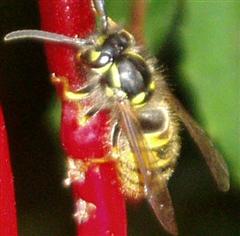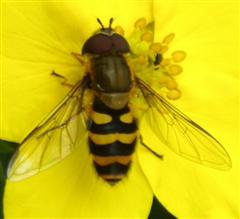Identify wasps
"If in doubt - treat it as a wasp."

Flight and buzz
The honey bee, bumblebee and wasp have similar flight, buzz and overall appearance. The harmless hoverfly can look superficially like any of the other three because, to avoid being eaten, it mimics the appearance of a stinging bee or wasp. The hoverfly uses a hovering flight different from the other three and does not usually buzz unless wing beats are slower due to being trapped. You may hear a slight whine from fast wing beats
Antennae, waist, eyes, wings, leg colour
Wasps, honey bees and bumblebees have two pairs of wings while the hoverfly has one pair of wings. While not flying the wasp holds the two pairs of wings together so that they appear to be just one pair of wings. Wasp wings seem very narrow and, at rest, they're held in a very characteristic manner over the back very unlike the wide splayed wings of the hoverfly and bees. You will notice that the eyes of the hoverfly are large like a housefly while the other three have smaller eyes. The antennae of the wasp and bees are very long unlike the hoverfly which has very short antennae. Unlike honey bees, bumblebees and hoverflies the wasp has a very, very narrow waist. This is where we get the word "waspish" to describe a very thin person. The wasp usually has yellow legs and the bees have black legs. Hoverflies can have yellow or black legs.
Behaviour

Only wasps show a marked interest in us. Bees and hoverflies are interested in foraging at flowers. Wasps visit flowers in a similar way to bees and hoverflies. Honey bees show a limited interest in sweet food and drinks but wasps show a marked interest in our food and drinks. Hoverflies and bumblebees are solitary in their activity whereas honey bees and wasps may attend a sweet food source in a gang. Only the hoverfly does not nest whereas honey bees, bumblebees and wasps all have the habit of coming and going from one site in the garden where their nest is. The wasp is the only one of these insects showing an interest in food waste for example in dustbins
Identification videos
Bumble bee
Hoverfly
Honey bee
Wasp
